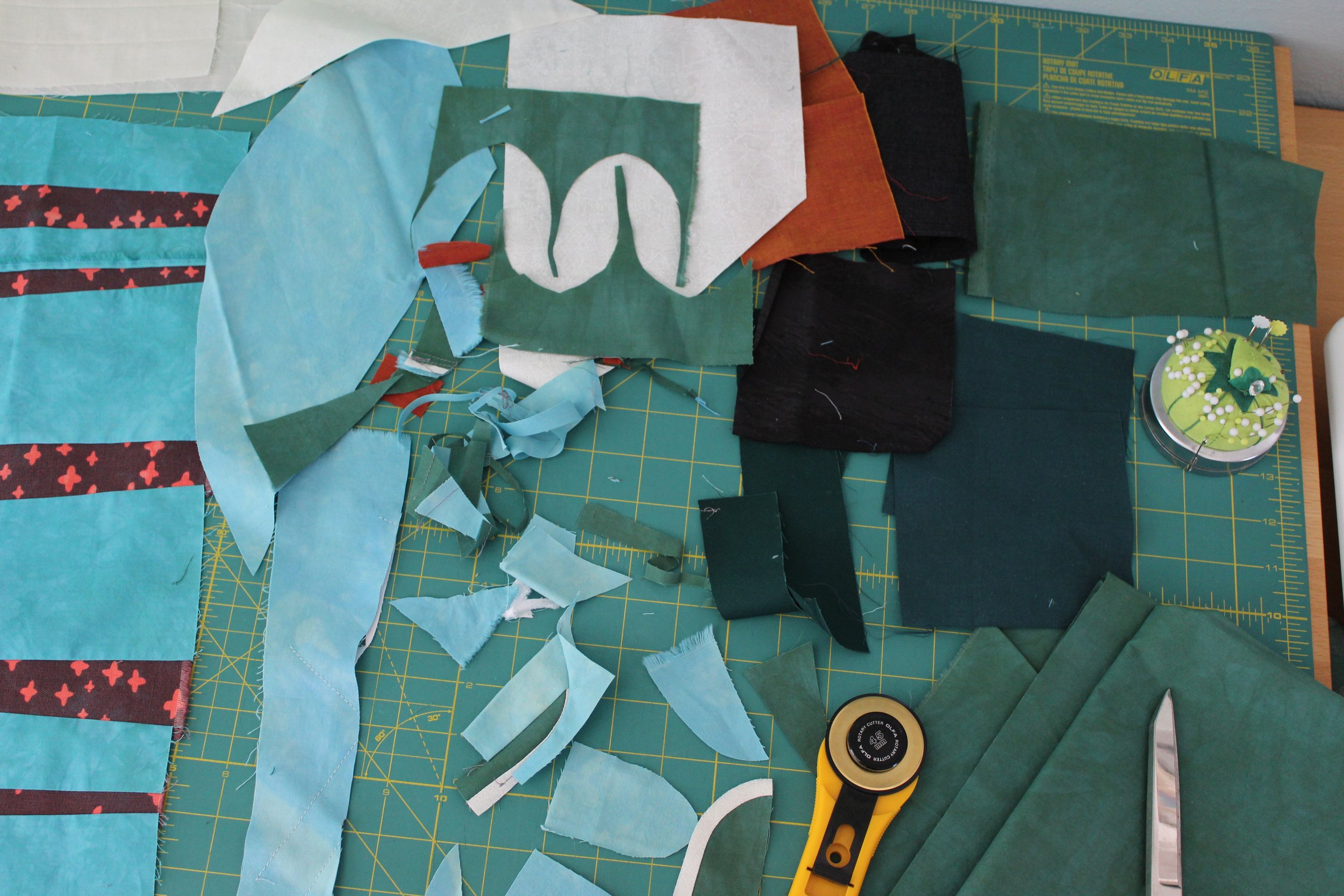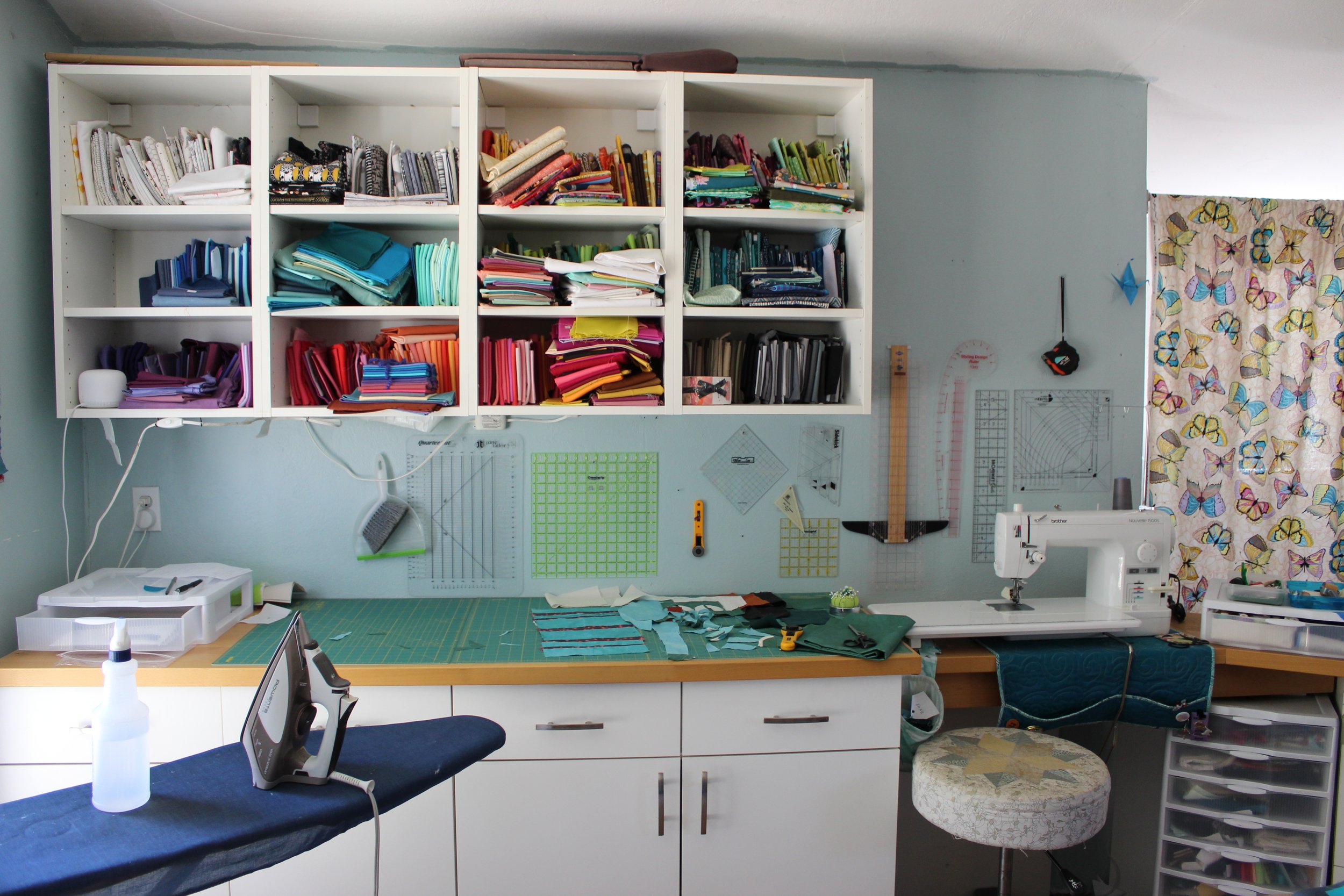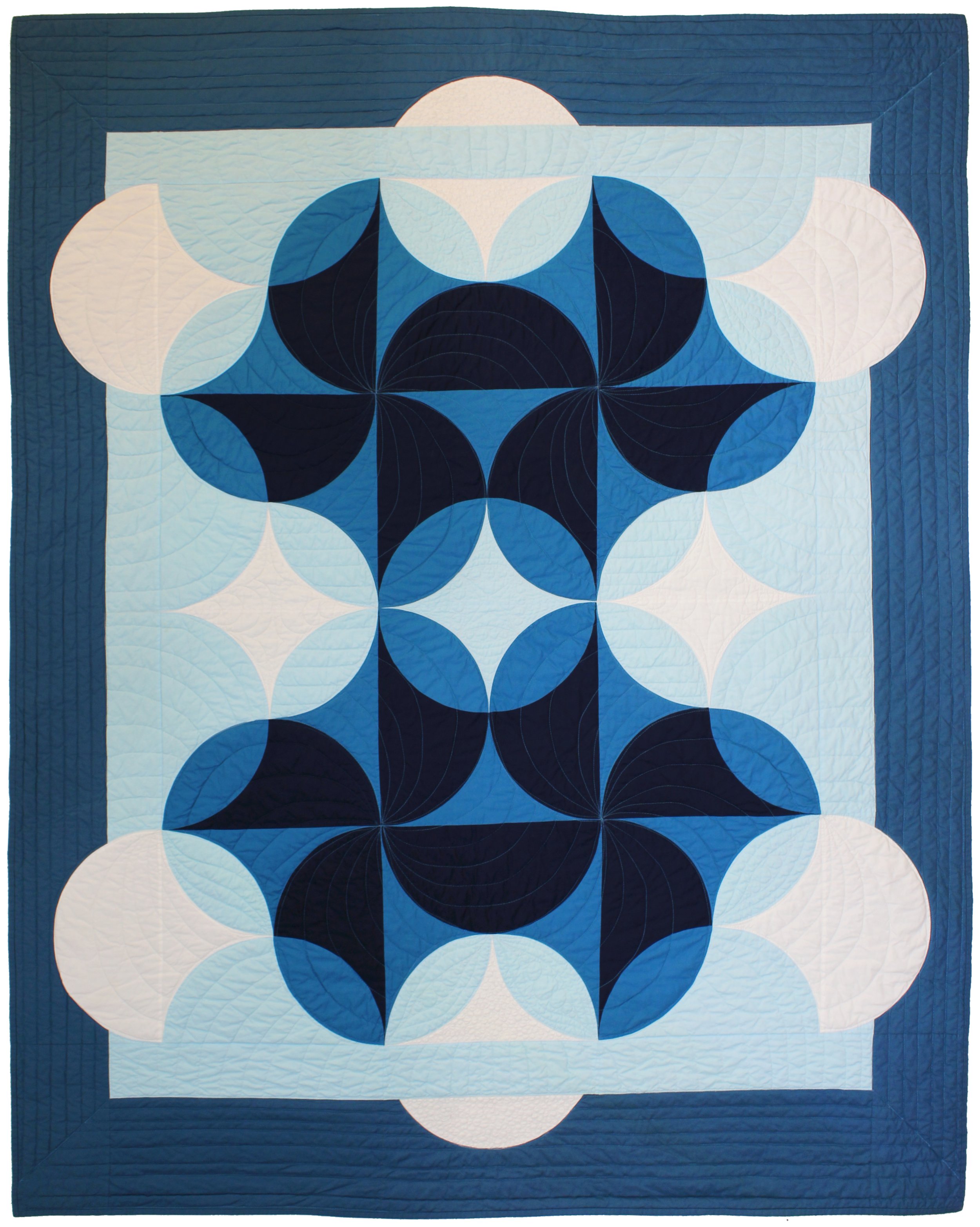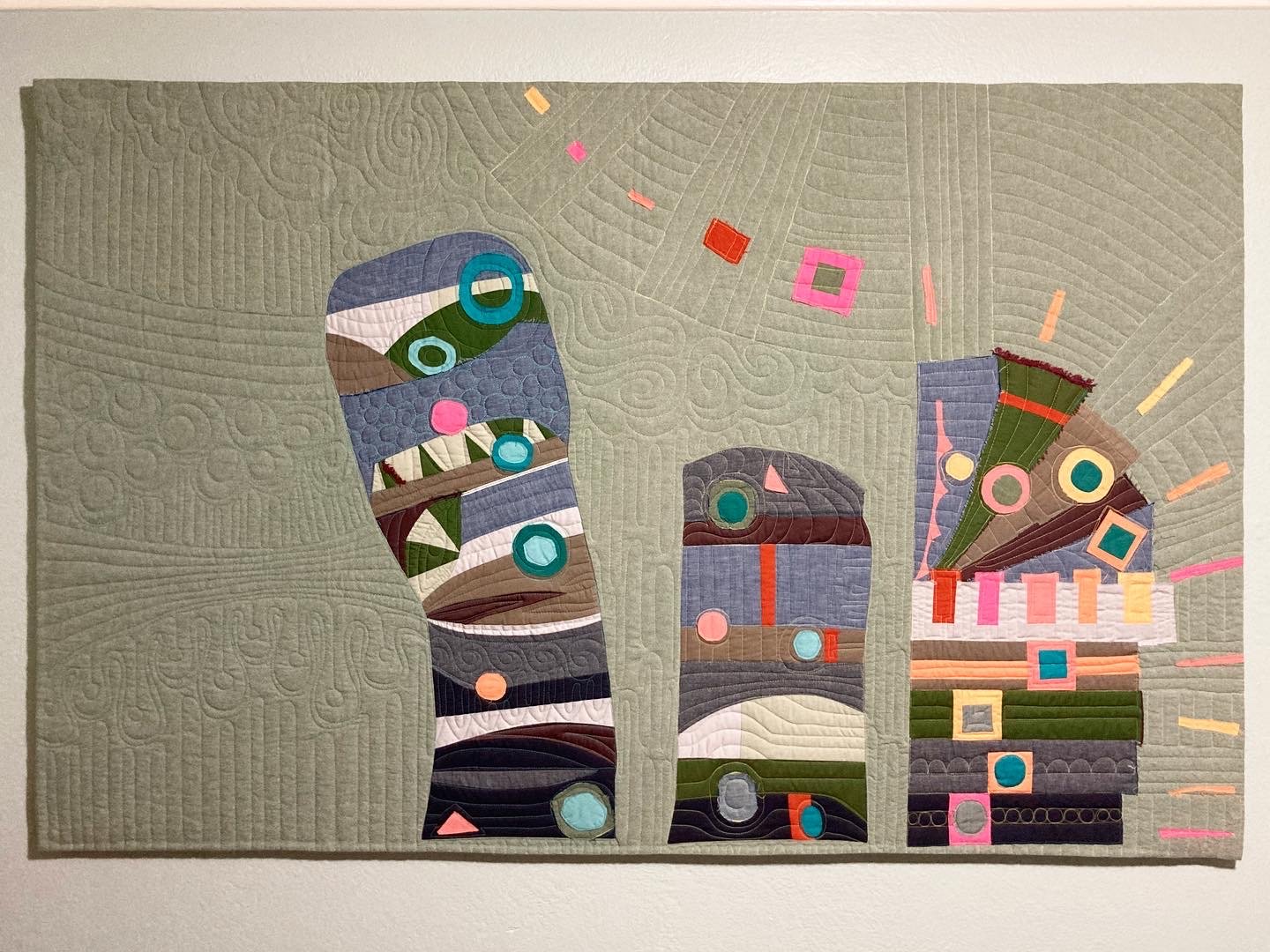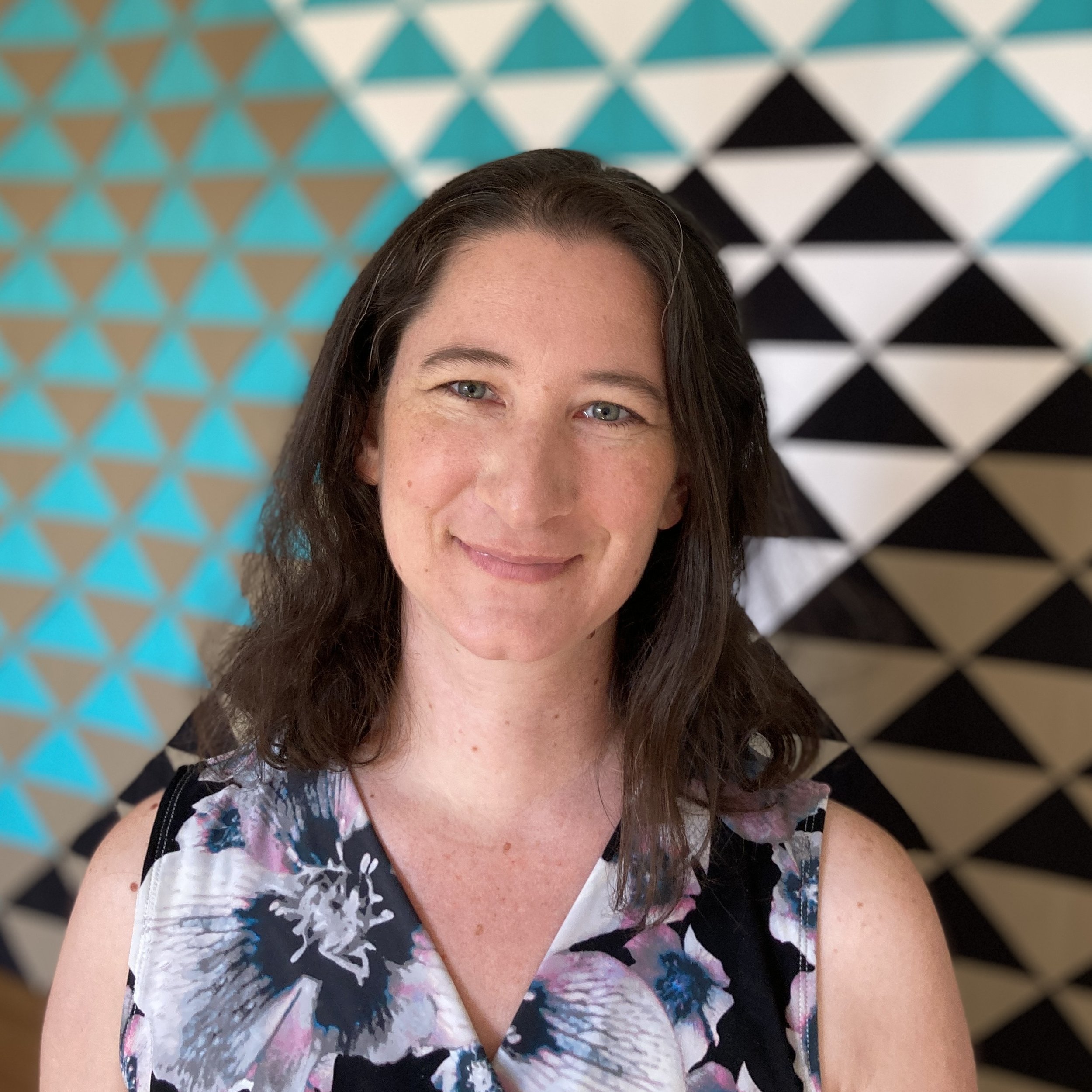Voluminous
Karen Bolan
Voluminous, quilt, 12 x 12 inches
“From now on, I have to call myself an artist.”
Interview by L. Valena
September 15, 2023
I can't wait to hear all about your creative process. Could you start by describing the prompt that you responded to?
It looked like a homemade book. There was a series of photographs to show the book from different angles. It was beautiful! And it gave me this almost “medieval book of spells” feeling. It had some metallic and gemstone accents, and ribbons. It was gorgeous. And mysterious because I didn't get to see inside. And that's what got me thinking about what I would do: I really wish that I could see inside this book. It was tempting.
What were some of your other thoughts and feelings about it?
I wrote some notes to stay organized and focused. From the purely aesthetic side, I wrote down teal, black, copper, and cream as a color palette guide, and I sketched out a couple of the details that were interesting to me. On the spine of the book, you could see some folded papers and stitching in an X pattern, which was really intriguing and easily translated into the quilting world with that geometry. I noticed how the ribbons folded over near the knot, so I sketched a detail that was an abstraction of that. I really liked the edge of the cover. And then of course, there were the pendants. I sketched those four shapes, and I had the color palette. My mind was really just wishing that I could see inside this book. I kept wondering, “What could be inside? Is it ancient knowledge? Is it secrets like a diary? Or is it recipes and spells?” I figured that it had to be one of those. [laughs] That's where I started.
So many different types of secrets! Where did you go from there?
I took some time after seeing the pictures. I like to get a little bit of separation from the inspiration and let things simmer a little bit. I wasn't trying to remake a book of spells, I was trying to make a quilt that felt like it was connected to the inspiration art, but my own work. And I don't make books, though maybe I should after looking at this! So I took a break from actively working on it and kept these ideas, these shapes, and these colors moving around in my head.
I decided that since this book felt handmade, I would pick out some fabric that I’d dyed; that fabric is hard for me to use because it's precious. I picked from my dyed fabric and a couple of other scraps that felt like they belonged.
When I do improvisational quilting patchwork, I try to separate myself from a lot of my own control on the piece. I like to look at what I have chosen and figure out if there’s a natural way that they want to fit together. I started by piecing together some stripes because I was inspired by this spine of the book. How could I use this in the quilt world? And what about this binding on the edge? The stripes could either serve the purpose of connecting to that spine, or from that outer edge. Then I laid out a pretty traditional nine-patch (a square grid of nine fabrics, arranged in three rows of three). It was looking very symmetrical. I wanted to throw in some of the curves from the metallic pendants, so I cut some curves and started trying to put it together. That’s when I came up against a limitation of my technique. They weren't sewing in that well. I'm going to blame them for that, instead of me for not actually cutting them out to be the right size. Either way, they weren't agreeable. After doing one good curve and two pretty bad ones, I wasn't interested in trying to make the fourth piece. I needed to find another way to use these pieces. That's when it started to shift into something new (the magic of improv patchwork started to happen).
I cut the squares, curves, and pieced units into smaller pieces, and ended up with all of these weird leftover shapes. So I just started trying to put the pieces back together into a puzzle even though I didn't know how it would look in the end. Every time you sew a seam, you lose a little bit of the fabric between the two pieces, so the shape changes. If things look like they are going to match up and then you sew them together, they might not match up anymore. The whole piece might be shaped differently, especially when you're working with curves. So I had to re-evaluate and shift my plan. [laughs]
I ended up with this strangely-shaped central panel, with a lot of inset curved pieces going in different directions, and the remnants of those original curved pieces. It was such a weird shape. I wasn't really happy. This center part was what I wanted it to be, but I didn't feel like it could stand on its own. At that point, I brought over some of the fabric that I started with to see what it would look like with more negative space around it. I liked the light blue hand-dyed fabric, and I had another larger piece of the darker green, and I liked that on the other side. But then it felt too much like piece-piece-piece, three separate stories that were not connected. I added some little triangles, which helped lead the story from part to part, but really was just an excuse to play with some more triangles, because I like triangles. So I ended up with a relatively square piece, which is nice because those are easy to finish off.
How big is this piece?
It finished at 12 x 12.
In the background, I've really been exploring what it means to call yourself an artist if you're a quilter. I've been feeling hesitant to use that word. It doesn't feel natural when I say I'm an artist because, well, I'm “just a quilter.” I've had a couple of external validations that make me believe that I should call myself an artist these days. And yet it's still a little bit uncomfortable to use that word when I talk about myself. At one point, I got this Best In Show prize at an art show and I was the only quilt in the show. That was pretty cool. I thought, “From now on, I have to call myself an artist,” but that only felt comfortable for like two days. But I got some prize money, and I went to the art supply store and bought all of these canvases, and my mom gave me a staple gun. I decided I would play more with stretching quilts on rigid frames.
Anyway, that's the long, tangential way to tell you: I decided from the beginning of this project that I would make something that I can stretch on this canvas, because that’s a technique I want to play more with. And 12 x 12 is the size of these little canvases that I have.
It’s unusual for quilts to be shown that way. It contradicts this idea of something soft and comforting if you stretch it and put it on something hard.
It's so cool though because there are so many unbelievable artists who are making quilts that have nothing to do with something that you would sleep under. It's not even the same animal. I have a Bisa Butler print over here, you know? It has nothing to do with something warm and cuddly. It’s just really good art.
Totally! It’s just art, but the cuddly side of art. To make my quilt less cuddly, I had to get a little bit more fabric around it, to be able to wrap it around the frame. I've seen some people wrap just patchwork on a frame, unquilted. But I really like the texture that you get from quilting, and the opportunity to add lines, which direct the eye and change the story. I really enjoy quilting, so I decided to only layer a 12-inch piece of batting behind the center of the patchwork, and I quilted through that. I extended my quilting lines across the edge, but I don't like having the batting wrap around the frame because it gets really bulky and not that square by the time you stretch it.
So anyway, I made this cheating sandwich (sandwich is what you call the three layers of a quilt: patchwork top, batting, and backing fabric) and then I quilted it. I tried to stay in the improv mindset while I was quilting, not planning it all out meticulously, which is something that I also enjoy doing, but tried not to do that this time around. I meandered around the shapes and then played with not just echoing the lines I’d already sewn. I was pleased with how the quilting turned out. And I got to use my staple gun.
So satisfying! [both laugh] How do you like working from a prompt?
One of the things I like about improv is that, by its nature, it will always surprise you. I thought I was starting to veer pretty far away from the inspiration of the book, but when I looked at it again, I noticed that we did have these three sections splitting the piece into thirds. It felt like it could represent a book with a cover, an inside, and a back cover. The back cover is the boring part, the front cover gives you a bit of a secret about what's inside, and the inside is the juicy part. That's exactly how I felt about this book that I saw: there must be something really juicy inside that I wasn't able to see. Then there I was, able to imagine what that juicy bit could be. So it surprised me by being more related to the book than I expected. That is the magic about working improvisationally from a prompt: it’s still there (in your head) even if you’re not focusing on reproducing it.
It's amazing how that happens sometimes. It seems like it just naturally flowed in some way. How does this piece relate to the rest of your work?
Well, part of my business is teaching and lecturing about my quilts. One of my lectures is about engineering and the design process because I'm also an engineer. All the quilts I share in that lecture are meticulously planned, with every step thought out and optimized. I also really enjoy improvisational quilting, and I feel like those two sides of my personality don't usually come together in my quilts (in the same quilt). On one side, I have this really strong, super-methodical body of quilting work, and on the other hand is this emerging body of quilting work that’s improvisational and really emotional.
Lately I've been feeling that balance is a little bit broken, so I decided to do more improv, and this is part of that. With the surprise and the looseness of improv, I can look back on it and realize that it was trying to remind me of something that I have been hiding from myself. I see a lot of that coming out in my improv practice. I'm not paying for therapy right now, but this is maybe as close as I can get to trying to tap into that part of myself that I don't listen to when I'm thinking about it.
That's beautiful. Well, is there anything that we haven't covered yet? If you were interviewing yourself right now, what would be the next question you would ask yourself?
I always like it when people ask me at lectures, “What are you working on next?” But I don't feel like I have a great answer for that right now. I just finished doing a lot of heavy deadline-related things that I had procrastinated on, so I'm feeling a little bit defeated in terms of my creative energy. But on the machine behind me, I have an improv quilt that I made almost two years ago that I really want to finish. I do like to make sure that I have that balance between something methodical and something emotional, making sure I find the time to do both. Actually, making the time is the priority, not finding it.
Awesome. Do you have any advice for another artist approaching this project for the first time?
When I’ve done this type of collaborative work before, what worked for me was looking at the piece, really investigating it aesthetically, as well as what it brings up emotionally. Then sketching out something really super basic and setting it aside. For me, that process really works well: investigate, wait, start to make. I didn't look back at the images of the original artwork once I started making my own piece because I wanted to ensure that artistic separation. I didn't want to make something that wasn't mine and it's sometimes easy to do that.
Okay, great. Is there anything else you want to say on the record?
On the record, this was really fun!
Call Number: M80VA | M82VA.boVo
Karen Bolan is a quilt artist, teacher, and quilt pattern designer in northern California. With a background in civil engineering, it’s no surprise she is drawn to the layers of design and expression possible in quilting, loves experimenting, and strives to find efficiencies in process and material use. She teaches nationally and her work has been featured in local and international quilt and art shows. You can learn more about Karen's work at www.karenbolan.com.



